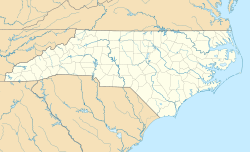Herring House (La Grange, North Carolina) facts for kids
Quick facts for kids |
|
|
Herring House
|
|
| Location | Northwest of La Grange off SR 1503, near La Grange, North Carolina |
|---|---|
| Area | 5 acres (2.0 ha) |
| Built | 1801 |
| Architectural style | Federal |
| NRHP reference No. | 73001356 |
| Added to NRHP | October 25, 1973 |
The Herring House is a really old and important home near La Grange, in Lenoir County, North Carolina. It was built a long, long time ago, in the early 1800s. This farmhouse is a great example of the Federal style, which was popular back then. It was built by one of the first families to settle in this area. Because of its history and cool design, the Herring House was added to the National Register of Historic Places (NRHP) in 1973. This means it's officially recognized as a special place worth protecting!
History of the Herring House
The Herring family first came to what is now Lenoir County way back in the early 1700s. A man named John Herring (who lived from 1684 to 1760) was an important person. He was even a member of the North Carolina Colonial Assembly, which was like the government back then. In August 1720, he received a special document called a land patent. This patent officially gave him ownership of land just a few miles from where La Grange is today.
People believe the Herring House was built by either John's grandson, Edward Matchet Herring (1755–1825), or his great-grandson, William Herring (1779–1830). There's a brick in one of the chimneys that has "1801" marked on it. This is probably the year the house was built. The house is located on a dirt lane about 0.4 miles west of Ed Herring Road (State Route 1503).
On October 11, 1889, William's youngest son, Joshua James Herring, Sr., gave the property to his own son, Needham Whitfield Herring (1856–1942). At that time, the home included the house and 314 acres of land. When experts studied the Herring House in the 1970s for its historical importance, it was still owned by a member of the Herring family. The house was officially added to the National Register of Historic Places on October 25, 1973.
Architecture and Design
The Herring House is a two-story building made of wood. It's built in the Federal style, which was popular in the United States from about 1780 to 1830. The house sits on a foundation made of bricks laid in a special pattern called Flemish bond. This pattern makes the bricks look very neat and strong.
The front of the house faces south and is five bays wide. A "bay" is like a section of the house, usually marked by windows or doors. The main entrance is in the middle of the front. Above the door, there's a transom, which is a small window. A porch was added in the 20th century. This porch has a hip roof (a roof that slopes down on all four sides) and wraps around the east side of the house.
On each end of the house, there are two bays and a chimney made of Flemish bond bricks. The brick that says "1801" is found in the chimney on the west side. The windows in the house are a bit narrow. On the first floor, the windows are "nine-over-nine" sash windows. This means they have nine small glass panes in the top part and nine in the bottom part. On the second floor, the windows are "nine-over-six" sash windows, with nine panes on top and six on the bottom.
Inside the house, there's a central hallway. On either side of this hallway, there's a large parlor, which is like a formal living room. The walls in the hallway are plastered, but the lower part has wainscoting. Wainscoting is a decorative wooden paneling that covers the lower section of a wall. In the other rooms, the plastered walls have a molded chair rail. A chair rail is a strip of molding that runs around the room, usually at the height where the back of a chair would hit the wall.
The main staircase is on the left side of the central hallway. It's an "open-string" staircase, meaning the side of the stairs where the treads and risers are attached is open and visible. The staircase has curved brackets (decorative supports) and square balusters (the vertical posts that support the handrail). There's also another staircase, which is enclosed, located in the parlor on the east end of the house.



